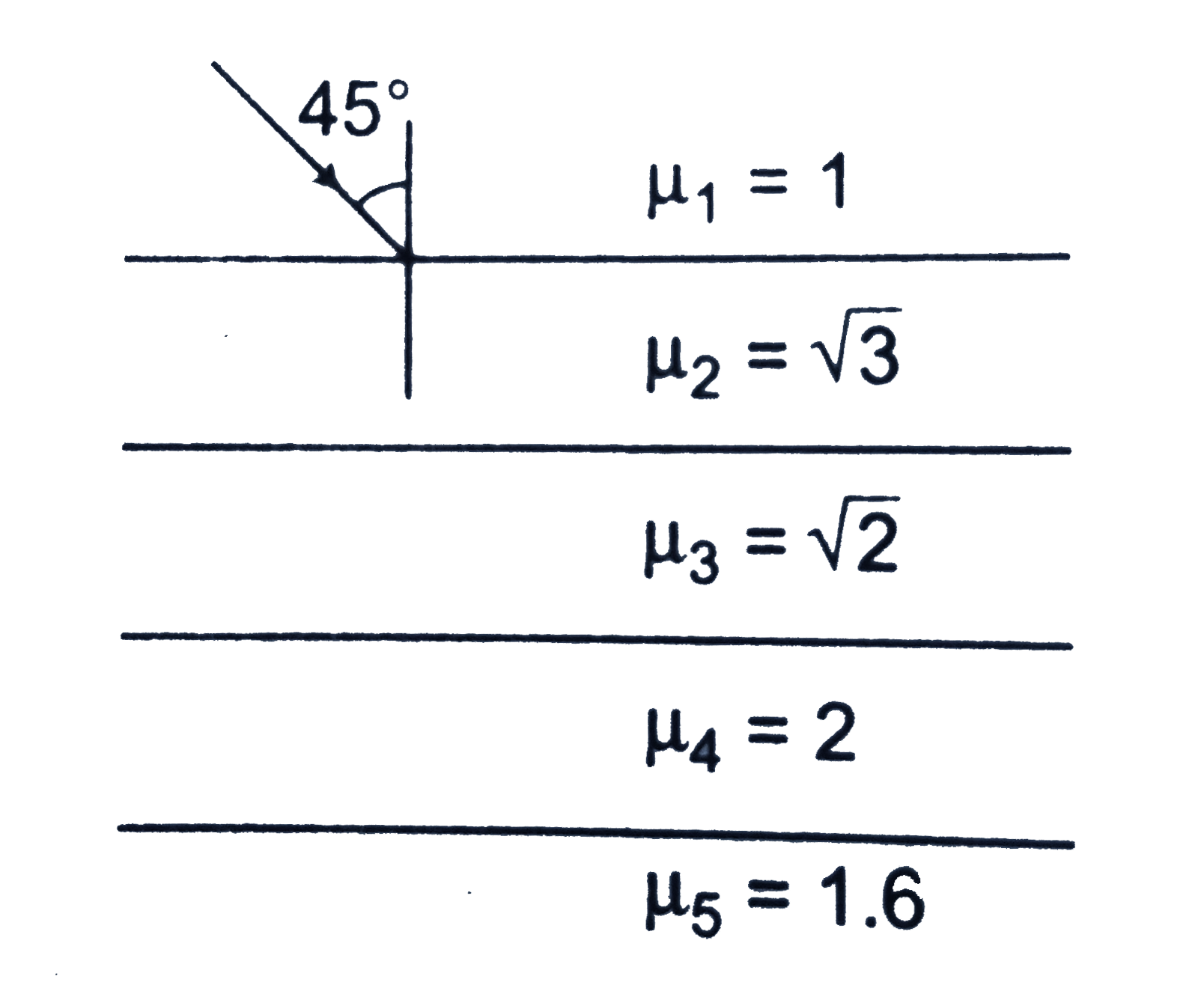Let the x-z plane be the boundary between two transparent media. Medium 1 in has a refractive index of and medium 2 with has a refractive index of . A ray of light in medium 1 given by the vector is incident on the plane of separation. The angle of refraction in medium 2 is:
To solve the problem, we need to find the angle of refraction r when a ray of light passes from medium 1 to medium 2 at the boundary defined by the x-z plane. Here are the steps to solve the problem:
Step 1: Identify the vectors and refractive indices
The incident ray in medium 1 is given by the vector:
→A=6√3^i+8√3^j−10^k
The refractive index of medium 1 (μ1) is √2 and for medium 2 (μ2) it is √3.
Step 2: Calculate the angle of incidence i
To find the angle of incidence, we first need to find the direction of the incident ray. The direction vector can be obtained from the components of →A in the x-y plane, ignoring the z-component.
The magnitude of the vector →A is:
|→A|=√(6√3)2+(8√3)2+(−10)2=√108+192+100=√400=20
The direction cosines can be calculated as:
cosi=−1020=−12
This gives us:
i=cos−1(−12)=120∘
Step 3: Apply Snell's Law
Using Snell's Law:
μ1sini=μ2sinr
Substituting the values:
√2sin(120∘)=√3sinr
Step 4: Calculate sin(120∘)
We know:
sin(120∘)=sin(180∘−60∘)=sin(60∘)=√32
Step 5: Substitute and solve for sinr
Substituting sin(120∘) into Snell's Law:
√2⋅√32=√3sinr
This simplifies to:
√62=√3sinr
Dividing both sides by √3:
sinr=√62√3=√22
Step 6: Find the angle of refraction r
Now, we find r:
sinr=√22
This gives us:
r=45∘
Final Answer
The angle of refraction r in medium 2 is 45∘.
---
The incident ray in medium 1 is given by the vector:
→A=6√3^i+8√3^j−10^k
The refractive index of medium 1 (μ1) is √2 and for medium 2 (μ2) it is √3.
To find the angle of incidence, we first need to find the direction of the incident ray. The direction vector can be obtained from the components of →A in the x-y plane, ignoring the z-component.
|→A|=√(6√3)2+(8√3)2+(−10)2=√108+192+100=√400=20
cosi=−1020=−12
This gives us:
i=cos−1(−12)=120∘
Using Snell's Law:
μ1sini=μ2sinr
Substituting the values:
√2sin(120∘)=√3sinr
We know:
sin(120∘)=sin(180∘−60∘)=sin(60∘)=√32
Substituting sin(120∘) into Snell's Law:
√2⋅√32=√3sinr
This simplifies to:
√62=√3sinr
Dividing both sides by √3:
sinr=√62√3=√22
Now, we find r:
sinr=√22
This gives us:
r=45∘
The angle of refraction r in medium 2 is 45∘.
Topper's Solved these Questions
- GEOMETRICAL OPTICSBOOK - CENGAGE PHYSICS ENGLISHCHAPTER - GEOMETRICAL OPTICSEXERCISE - Solved Examples
15 Videos
- GEOMETRICAL OPTICSBOOK - CENGAGE PHYSICS ENGLISHCHAPTER - GEOMETRICAL OPTICSEXERCISE - Exercise1.1
14 Videos
- ELECTRON,PHONTS,PHOTOELECTRIC EFFECT & X-RAYSBOOK - CENGAGE PHYSICS ENGLISHCHAPTER - ELECTRON,PHONTS,PHOTOELECTRIC EFFECT & X-RAYSEXERCISE - dpp 3.3
15 Videos
- HEATING EFFECT OF CURRENTBOOK - CENGAGE PHYSICS ENGLISHCHAPTER - HEATING EFFECT OF CURRENTEXERCISE - Thermal Power in Resistance Connected in Circuit
27 Videos
Similar Questions
The x−y plane is the boundary between two transparent media. Medium-1 with z≤0 has a refractive index √2 and medium -2 with z≤0 has a refractive index √2. A ray of light in medium -1 given by vector A=√3ˆi−ˆk is incident on the plane of separation. The unit vector in the direction of the refracted ray in medium-2 is
View Solutionx-y plane separates two media, z≥0 contains a medium of refractive index 1 and z≤0 contains a medium of refractive index 2. A ray of light is incident from first medium along a vectorˆi+ˆj−ˆk. Find the unit vector along the refracted ray.
View Solution
Knowledge Check
The refractive index of a medium is √3. What is the angle of refraction, if unpolarizing light is incident on the polarising angle of the medium ?
A60∘B45∘C30∘D0∘
A ray of light passes from a medium A having refractive index 1.6 to the medium B having refractive index 1.5. The value of critical angle of medium
A is….
View SolutionA ray of light is incident on the surface of a glass plate of refractive index √3 at the polarising angle . The angle of incidence and angle of refraction of the ray is
View SolutionA prism having refractive index √2 and refractive angle 30∘ has one of the refractive surfaces polished. A beam of light incident on the other surfaces will trace its path if the angle of incidence is
View SolutionA prism of apex angle A=60∘ has the refractive index μ=√2. The angle of incidence for minimum deviation is
View SolutionAn optical fibre having core of refractive index √3 and cladding of refractive index 1.5 is kept in air. The maximum angle of acceptance is
View SolutionIf a prism having refractive index √2 has angle of minimum deviation equal to the angle of refraction of the prism, then the angle of refraction of the prism is:
View SolutionIn the figure shown, the angle made by the light ray with the normal in the medium of refractive index √2 is

View Solution
